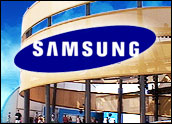
Staking its claim to leadership in the converging worlds of mobile computing, Web browsing and cellular communications, Samsung has become the latest handset vendor to roll out a WiFi-enabled phone.
Samsung said it will make its SPH-M4300 available in its home market of Korea later this month. In addition to being able to access the Web via WiFi Internet connections, the device features a 1.3-megapixel camera and a 2.8-inch LCD and will run on the Pocket PC operating system made by Microsoft.
Samsung has taken to testing products in Korea before rolling them out onto the worldwide market, something it is eager to do to keep and gain market share in an increasingly competitive environment.
Other Innovations
In addition to the WiFi ready phone, Samsung’s recent innovations include color screens, screens that swivel and phones with large hard drives, including one model with a 3 GB hard disc drive.
The Samsung handset joins earlier models, many just hitting the market, from Nokia and Hewlett-Packard, whose iPAQ hand-helds are WiFi enabled.
WiFi use on mobile phones is seen as having potential to spread mobile Web use by giving phone users more options and price points for that connectivity. WiFi could offer a more cost effective way for users to access the Web from mobile devices by minimizing the air time used to go online.
Reducing that cost could in turn prompt users to be more willing to spend on added services such as streaming music or news video clips or on true m-commerce purchases enabled by the handsets.
“Air time cost and usage is an impediment to mobile Web use,” said Gartner analyst Ben Wood, who noted that many phones now in use have the capability to access the Internet, but that many users never attempt to do so.
VoIP Possibility
That’s in part because cost is not the only hurdle, with many devices still too cumbersome and their keyboards too small to be used to navigate the Web for long periods of time. Some phone companies are already pushing voice-activity technology or even motion sensitive phones to overcome those limitations.
“The networks are being built out, the devices will get better in time,” Wood told the E-Commerce Times. “The more choices people have to get online from their mobile phones, the more likely they are to take advantage of that feature.”
Other mobile phone companies have pushed WiFi connectivity as a way to enable free or virtually free mobile calling by using WiFi to then access Voice over Internet Protocol (VoIP) services, which would send calls over broadband networks at a sharp discount to what air time costs.
In fact, one consequence of the WiFi technology could be to prompt mobile carriers to adjust their air time charges for Web use to keep customers using that direct option.
For Samsung, the phones are just one part of a stated strategy to be a leader in the convergence of various technologies. Because it makes devices as well as semiconductor chips, Samsung believes it is uniquely positioned to thrive in the emerging marketplaces.
Integrating Devices
Samsung said at its annual Mobile Solution Forum in Taipei, Taiwan, this week that it can help developers integrate a range of devices, from MP3 players to digital cameras and personal organizers, into single devices.
The company unveiled numerous innovations, including new chipsets aimed at making mobile gaming and video more realistic.
Samsung executives said the company was intent on setting standards for mobile semiconductor development. Samsung said the demand for such technology is outstripping forecasts, with some US$46 billion worth sold last year alone.






















































Social Media
See all Social Media